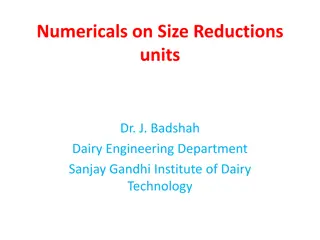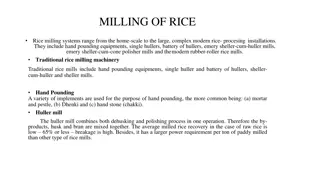Understanding End Mills in Milling Operations
An end mill is a crucial tool in milling operations, offering versatility in cutting directions. This module explains the types of end mills, factors to consider when choosing the right one, substrate comparison, and basic end mill nomenclature. It also covers different types of milling operations and guides on selecting the correct number of flutes based on various factors.
Download Presentation

Please find below an Image/Link to download the presentation.
The content on the website is provided AS IS for your information and personal use only. It may not be sold, licensed, or shared on other websites without obtaining consent from the author. Download presentation by click this link. If you encounter any issues during the download, it is possible that the publisher has removed the file from their server.
E N D
Presentation Transcript
Module 1 MILLING 1
2 WHAT IS AN END MILL? An endmill is a type of milling cutter. They are sometimes referred to as simply cutters or slot drills Used in industrial milling applications It is distinguished from the drill bit in its application, geometry, and manufacture. While a drill bit can only cut in the axial direction, a milling bit can generally cut in all directions, though some cannot cut axially. Endmills are used in milling applications such as profile milling, tracer milling, face milling, and plunging.
3 CHOOSING THE RIGHT END MILL A wide range of options & considerations: High Speed Steel (HSS) High Speed Cobalt (HSCo) Powdered Metal (PM) Solid Carbide Coated (AlTiN) or Un-coated (Bright) Square End vs. Ball Nose Center Cutting vs. Non-Center Cutting Single End vs. Double End Shank type
4 CHOOSING THE RIGHT PRODUCT Things to consider: The workpiece material, including hardness The tool path (i.e slotting) Wet or dry application Number of pieces to be produced Manual or power feed The machine: age, style, strength, condition, horsepower, rigidity, spindle speed
5 SUBSTRATE COMPARISON 1. High Speed Steel (HSS) & Cobalt (HSCo) Low cost Tough Versatile Shock absorbing Increased heat and wear resistance with Cobalt vs. HSS 2. Powdered Metal (PM) Higher tool cost (than HSS/HSCo) Tougher and harder than HSS Most shock resistant Versatile Great for high temp alloys (Inconel, Waspalloy)
6 SUBSTRATE COMPARISON 3. SOLID CABIDE Hardest Material Most wear resistant Highest cost, especially on larger sizes Most brittle Longest tool life High productivity and faster operating parameters (up to 2.5 x that of HSS) Usually the best value for your money in most applications
7 BASIC END MILL NOMENCLATURE
8 BASIC END MILL NOMENCLATURE
9 TYPES OF MILLING
10 HOW MANY FLUTES? Selecting the correct number of flutes to use is dependent on: The material you are milling Dimension of the workpiece Milling conditions The table on the next slide is a guide to selecting the correct number of flutes.
11 HOW MANY FLUTES?
12 HELIX ANGLES 30 or 45 ? 30 is the industry standard helix angle A higher helix angle (45 ) reduces tool deflection by redirecting the cutting forces from a horizontal to a vertical direction Higher helix angle removes material quickly. Ideal for use in materials such as aluminum and other non-ferrrous materials.
13 SINGLE VS. DOUBLE END SINGLE OR DOUBLE END? Single end are the most commonly used end mills Double end End Mills have two cutting ends on the same tool. Both ends can be used to cut, which can reduce tool cost Endmill holders must have sufficient clearance to allow for the use of a double end cutter
14 BALL NOSE END MILL WHY A BALL NOSE END MILL? The end of the end mills are hemispherical. They are ideal for machining 3-dimensional contoured shapes in machining centres, for example in molds and dies. Also used to add a radius between perpendicular faces to reduce stress concentrations.
15 ROUGHING END MILL WHY A ROUGHING END MILL? Roughing end mills quickly remove large amounts of material. Utilizes a wavy tooth form cut on the periphery. These teeth form many successive cutting edges producing many small chips, resulting in a relatively rough surface finish. During cutting, multiple teeth are in contact with the workpiece reducing chatter and vibration. Almost always made of Cobalt or Powdered Metal
16 CENTER CUTTING CENTER CUTTING vs. NON-CENTER CUTTING Center cutting are by far the most common type Non-Center Cutting end mills should only be used for side milling operations
17 SHANK TYPES There are 2 common shank types in end mills: 1) Weldon Shank Simple clamping, without tuning of the cutting length Good capacity of torque transmission in roughing operations 2) Plain Shank Good choice for very small diameters Adjustable tool length No unbalance at high speeds (no flat, no screw) Suitable for precision clamping or shrink fitting
18 FORMULAE Below are the most common terms and formulas when it comes to end milling: SFM Surface feet per Minute RPM - Revolutions per Minute F Feed in Inches per Minute Ft Feed per Tooth D Cutting Diameter T - Number of Teeth SFM = D x RPM x .26 RPM = SFM x 3.82 D F = Ft x T x RPM Ft = F(Feed) T x RPM
19 END MILLS FEEDS AND SPEEDS Data from 2013 Drillco Product Catalog
20 END MILLS FEEDS AND SPEEDS Data from 2013 Drillco Product Catalog
21 TROUBLESHOOTING Tool Breakage Feed is too heavy Cut is too heavy Too much tool overhang Solution Reduce Feed Rate Decrease width and depth of cut Use shorter tool, hold shank deeper Regrind tool at earlier stage Too much wear Excessive Wear Speed is too fast Hard work Material Recutting of chips Solution Decrease spindle speed Use a coated tool Change chip size, use high pressure coolant Chipped Cutting Edge Lack of Rigidity Solution Change machine type or workpiece fixturing Use corner radius or corner prep Tool corner too sharp























